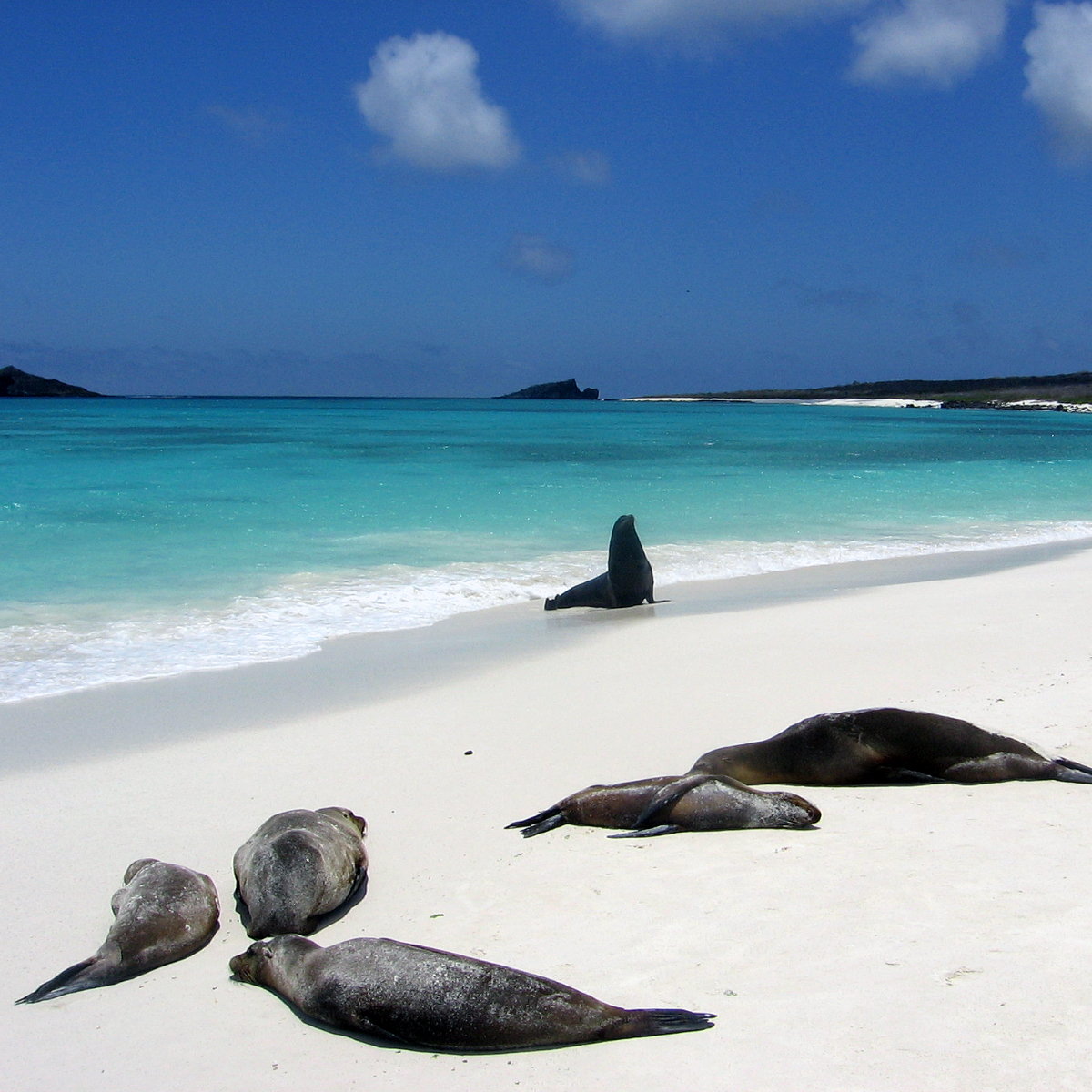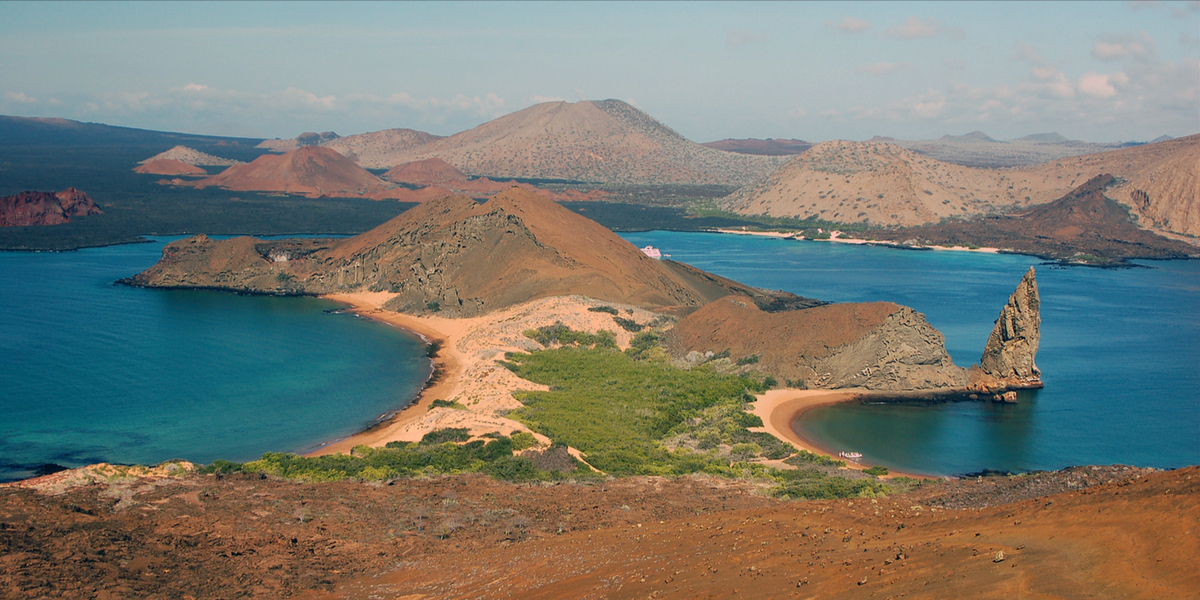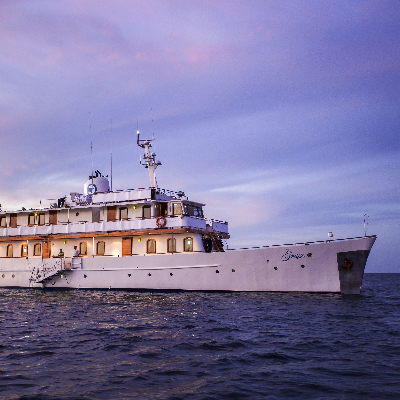If getting up close and personal to some of the world’s most fearless land and sea animals, whilst taking in the turquoise waters against a volcanic backdrop sounds like your kind of thing, then the Galapagos Islands are the place for you. The archipelago, which is made up of volcanic islands and dozens of islets and rocks is the perfect destination for avid explorers, divers, historians, wildlife enthusiasts’ as well as perfectly child friendly for a fun and relaxing family holiday.
A trip to the Galapagos can be as active or mellow as you wish. The diving is first class, giving you a crystal-clear window into the hidden world of fish, manta ray and Galapagos sharks to name a few. On land you will be greeted by giant tortoise, masses of sea lion and penguin as well as the iconic blue footed boobies. Hike to the tops of volcanoes through lush fields, or submerge in the history of Charles Darwin and the ongoing conservation works. Alternatively, take in the views from on deck while slowly cruising by, or relax on the peaceful beaches with a sundowner.
FEATURED YACHTS IN THE GALAPAGOS

ESPANOLA & FLOREANA
Located at the extreme southeast of the archipelago and is a real highlight. Espanola is relatively flat with small hills and is thought to be the oldest of the islands along with Santa Fe. Native animals can regularly be observed here including the waved albatross, mockingbirds and lava lizard to name just a few. Espanola is the only place that marine iguana are able to change colour in order to attract a mate!
Home of Post Office Bay and Devil’s Crown. This island is steeped in history. The Post Box is still operational today so pop a post card or two in and let it wing its way back home. Although this was the first island inhabited by man, it is still home to a vast amount of wildlife. Devils crown is also arguably one of the best snorkelling and dive spots in the Galapagos.

SAN CRISTOBAL & SANTA FE
San Cristobal island houses the only freshwater source in the archipelago and is of vital importance to the animals, residence and visiting tourist boats. San Cristobal has several visitor sites including the Interpretation Centre and so is well worth an explore. The beach here is also a great snorkelling spot.
Santa Fe Island offers one of the more beautiful and sheltered coves of the islands. Its turquoise lagoon is protected by a peninsula of tiny islets forming an ideal anchorage. Sea lions, land and marine iguana and great frigate birds are regular visitors and you may even spot the Galapagos snake.

SANTA CRUZ & PINZON
Santa Cruz is the second largest island and one of the most popular. It is home to the main town Puerto Ayora and also the Charles Darwin Research Station which is well worth a visit. Santa Cruz also homes many giant tortoise, sea lions, flamingos, land and marine iguana as well as the blue footed boobie.
Pinzon Island is a great spot for snorkelling and diving. A permit is required to step ashore, and so it a peaceful and beautiful spot, perfect for exploring the calm waters.

ISABELA & FERNANDINA
Isabela is the largest of the islands and a great spot for marine life. Here you can often see dolphins, whales, blue footed boobies and the Galapagos Penguins. It is also home to the popular tortoise breeding center and has more wild roaming tortoises than any other island. Isabela is also known for Punta Vicente Roca, which is a bay well protected from the ocean swells, a popular anchorage, kayaking and dive site.
The youngest and most volcanically active of the islands – Fernandina remains relatively untouched resulting in wildlife adapting to its habitat without predators. The cormorants have adapted to become flightless while land iguanas have flourished in their fearless home.
SANTIAGO & GENOVESA
Santiago is home to Sullivan Bay – one of the most magnificent volcanic sites in the world. Although there is little wildlife here, the eerie landscape that was formed only 150 years ago has a real beauty all of its own, and makes for fantastic hiking along solidified lava flow and through lava fields.
Genovesa, or ‘bird’ island, is one of the prettiest and most impressive islands in the Galapagos. Arriving onto Genovesa onto Darwin’s Bay – a beautiful white sand beach you will be surrounded by frigate birds and seals playing on the shores.


PINTA & DARWIN
Pinta Island was the home of Lonesome George – the most famous tortoise in the Galapagos. Pinta is not generally visited as part of the standard Galapagos cruises, as special permission is required from the National Park, making it seem even more special. We can get you on land if Pinta is on your bucket list!
If diving is what you came for, Darwin Island will not disappoint. Along with its neighbouring island, Wolf Island, diving here is first class, with Hammerhead and Galapagos sharks, manta ray, sea turtles and reef fish spotted regularly.
The Galapagos is a year-round destination, with two “seasons” distinguishing the time of year.
The warm, wet season runs from late December to June, with March and April being the hottest and wettest. There are usually daily showers in the afternoon, which dry up quickly thanks to the heat. January through to March are when water visibility is at its best and so ideal for diving and snorkelling.
The dry and cooler season runs from late June to December and brings relatively cool and dry weather with more overcast skies and occasional drizzle or mist during the day. This cooler weather also sees the start of the breeding season from many Galapagos animals including the sea lions, marine iguanas and sea birds. December, July and August tend to be regarded as “peak” season in line with the majority of the worlds school and festive holidays.
Getting to the Galapagos is relatively easy and perfectly paired with a stay on mainland Ecuador. Domestic flights arrive daily into Galapagos from both of Ecuador’s airports, Quito and Guayaquil, so you can choose whichever matches your other international flights and itinerary better. Fly into Baltra or San Cristobal Island depending on where your cruise starts. It’s a three-hour flight from Quito or 2 hours from Guayaquil and all flights go via Guayaquil.




